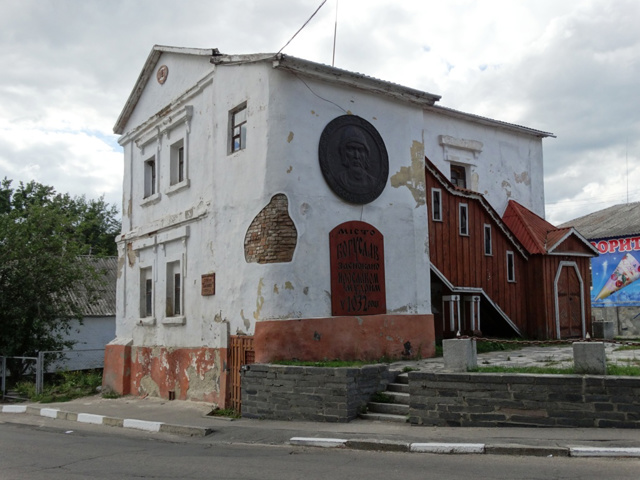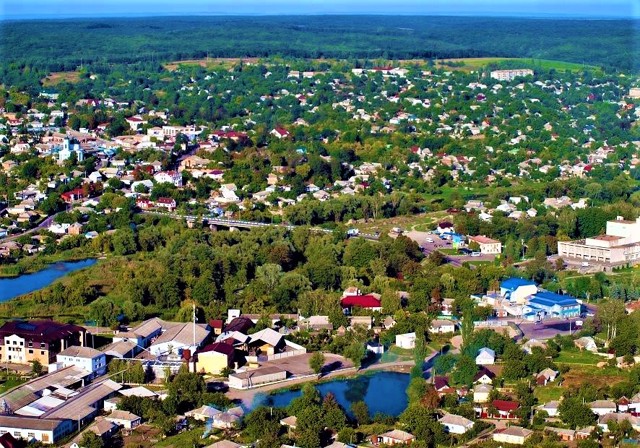Functional temporarily unavailable
General information about Bohuslav
The picturesque provincial town of Bohuslav is located on the granite banks of the river Ros, where two branches of the river form a rocky island (the Bohuslav granite exfoliation is considered a geological natural monument).
The city was founded by Yaroslav the Wise, was one of the most fortified outposts on the southern border of Rus. In the annals it was first mentioned in 1195 as Bohuslavl (the remains of a settlement were found). In 1240 it was destroyed by the Tatar-Mongols. Since 1362 it is under the rule of Lithuania, since 1569 - the Lithuanian-Polish state. Was at the epicenter of the national liberation war led by Bohdan Khmelnitsky, many popular uprisings.
The city of Bohuslav is the birthplace of the legendary Marusya Bohuslavka, sung by Panteleymon Kulish and I ...
The picturesque provincial town of Bohuslav is located on the granite banks of the river Ros, where two branches of the river form a rocky island (the Bohuslav granite exfoliation is considered a geological natural monument).
The city was founded by Yaroslav the Wise, was one of the most fortified outposts on the southern border of Rus. In the annals it was first mentioned in 1195 as Bohuslavl (the remains of a settlement were found). In 1240 it was destroyed by the Tatar-Mongols. Since 1362 it is under the rule of Lithuania, since 1569 - the Lithuanian-Polish state. Was at the epicenter of the national liberation war led by Bohdan Khmelnitsky, many popular uprisings.
The city of Bohuslav is the birthplace of the legendary Marusya Bohuslavka, sung by Panteleymon Kulish and Ivan Nechuy-Levitsky (a monument is erected). The artist and teacher Ivan Soshenko was born here, the poet Taras Shevchenko often visited the city, the writer Marko Vovchok lived here for some time (there is a manor-museum).
Some ancient monuments have been preserved. There are many recreation centers on the picturesque banks of the Ros.
Мальовниче провінційне містечко Богуслав розташоване на гранітних берегах річки Рось, де два рукави ріки утворюють скелястий острів (богуславське гранітне відшарування вважається геологічною пам'яткою природи).
Місто засноване Ярославом Мудрим, було одним з найбільш укріплених форпостів на південному кордоні Русі. У літописах вперше згадується в 1195 році як Богуславль (знайдені залишки городища). У 1240 році його знищили татаро-монголи. З 1362 року знаходиться під владою Литви, з 1569 року - Литовсько-Польська держава. Воно перебувало в епіцентрі національно-визвольної війни під проводом Богдана Хмельницького, багатьох народних повстаннь.
Місто Богуслав є батьківщиною легендарної Марусі Богуславки, оспіваної Пантелеймоном Кулішем та Іваном Нечуй-Левицьким (встановлено п ...
Мальовниче провінційне містечко Богуслав розташоване на гранітних берегах річки Рось, де два рукави ріки утворюють скелястий острів (богуславське гранітне відшарування вважається геологічною пам'яткою природи).
Місто засноване Ярославом Мудрим, було одним з найбільш укріплених форпостів на південному кордоні Русі. У літописах вперше згадується в 1195 році як Богуславль (знайдені залишки городища). У 1240 році його знищили татаро-монголи. З 1362 року знаходиться під владою Литви, з 1569 року - Литовсько-Польська держава. Воно перебувало в епіцентрі національно-визвольної війни під проводом Богдана Хмельницького, багатьох народних повстаннь.
Місто Богуслав є батьківщиною легендарної Марусі Богуславки, оспіваної Пантелеймоном Кулішем та Іваном Нечуй-Левицьким (встановлено пам'ятник). Тут народився художник і викладач Іван Сошенко, місто часто відвідував поет Тарас Шевченко, деякий час тут жила письменниця Марко Вовчок.
Збереглися пам'ятники старовини. На мальовничих берегах Росі є багато баз відпочинку.
Сплануй своє перебування у Bohuslav
What to see and where to go in Bohuslav
Tourist attractions and museums of Bohuslav

Bohuslav Region History Museum
Museum / gallery
The Museum of the History of the Bohuslav Region is considered to be one of the most creative historical museums in small towns of Ukraine.
It is located in Bohuslav in a two-story building of the former ministerial school in 1907.
The exposition presents an interesting collection of archaeological finds from the Paleolithic era, household items of Scythians and ancient Slavs, ancient Rus jewelry, Cossack relics, photographs and documents from the period of the Ukrainian Revolution, related to the Medvyn Uprising.
The original is decorated with exhibition halls in the spirit of its time. First, visitors enter a cave of the Stone Age, then go from the Scythian burial to the wooden frame of Bohuslav Castle, then find themselves in the interiors of a village house and a burgher house, where the iron stairs fall into the era of industrialization.
The branches of the Museum of the History of the Bohuslav Region are the Museum of Modern Decorative and Applied Arts, the Ivan Soshenko Memorial Museum-Estate, and the Marko Vovchko Memorial Museum-Estate.

Decorative and Applied Arts Museum (Kamyanytsya)
Architecture , Museum / gallery
The Museum of Decorative and Applied Arts in Bohuslav is a department of the Museum of the History of the Bohuslav Region.
It is located in the oldest civil building in the city, which locals call "Kamyanytsya". This archaic massive two-storey building with external wooden stairs was erected in the XVIII century for the Jewish religious school. The thickness of its walls reaches 1.2 m, the building has deep basements.
During the Second World War, the Gestapo was located here, then the Museum of Komsomol Glory.
Now in the restored "Kamyanytsya" there is an exhibition of modern local decorative and applied art - the work of Dybynets potters and masters of artistic weaving. In particular, the longest woven towel in Ukraine with a length of almost 105 m, created in 2017 in honor of the 985th anniversary of the founding of Bohuslav, is on display.
To view the exhibit, visit the nearby Bohuslav History Museum.

Granite outcropping (Yama)
Natural object
Bohuslav granite outcropping is a geological monument of nature. Rocks 10-12 meters high are located along the bed of the Ros River in the central part of Bohuslav.
In the valley of the river, granite blocks embedded in the ground are spectacularly scattered along its slopes. The age of the Bohuslav granites is 2 billion years. Picturesque rapids are formed in the place where Ros washes the granite island with two branches.
One such place with a deep bath overhanging a high rock is called "The Yama" by the locals.

Holy Trinity Church
Temple , Architecture
The Holy Trinity Church was built in Bohuslav in the 19th century on the site of an old church. Most of the funds for the construction were allocated by Oleksandra Branytska.
The temple is made in the style of late classicism. An architectural monument of national importance.
Belongs to the community of the Orthodox Church of Ukraine.

Marko Vovchok Memorial Manor-Museum
Architecture , Museum / gallery
The manor-museum of the writer Marko Vovchok is a branch of the Museum of the History of Bohulavshchyna.
Prominent Ukrainian writer Mariya Vilinska, who entered the literature under the pseudonym Marko Vovchok, lived in the Bohuslav region for almost 8 years (first in the city, and then in the house of Count Branytsky in neighboring Khokhitva). She came here with a man who was appointed forester. The story "Sly Khayimka" was written on Bohuslav motives.
The only museum in Ukraine, Marko Vovchok, was opened in half of the house where she lived. In the exposition - original things of the writer, embroidery, letters.
Reviews Bohuslav
Geographical information about Bohuslav
| {{itemKey}} | {{itemValue}} |
|---|---|
| Region |
Kyiv |















